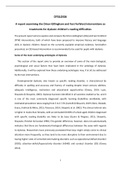DYSLEXIA
A report examining the Orton-Gillingham and Fast ForWord interventions as
treatments for dyslexic children’s reading difficulties
The present report aims to explore and compare the Orton-Gillingham (OG) and Fast ForWord
(FFW) interventions, both of which have been proposed to improve literacy and language
skills in dyslexic children. Based on the currently available empirical evidence, hereinafter
presented, an OG-based intervention is recommended to be used for pupils with dyslexia.
Some of the main underlying aetiologies of dyslexia
This section of the report aims to provide an overview of some of the main biological,
psychological and social factors that have been implicated in the aetiology of dyslexia.
Additionally, it will be explored how these underlying aetiologies may, if at all, be addressed
by the two interventions.
Developmental dyslexia, also known as specific reading disorder, is characterized by
difficulty in spelling and accuracy and fluency of reading despite intact sensory abilities,
adequate intelligence, motivation and educational opportunities (Davey, 2014; Lyon,
Shaywitz & Shaywitz, 2003). Dyslexia has been identified in all societies studied so far, and it
is one of the most commonly diagnosed specific learning disabilities worldwide, with
estimated prevalence rates ranging from 5 to 17.5% (Cainelli & Bisiacchi, 2019; Eden, Olulade,
Evans, Krafnick & Alkire, 2015; Peterson, 2014; Shaywitz et al. 2002). The clinical referral rate
is higher in males than females, with an estimated 60-80% of school-aged children diagnosed
with specific reading disability are likely to be boys (Quinn & Wagner, 2015; Shaywitz,
Shaywitz, Fletcher & Escobar 1990). This gender difference, however, does not automatically
indicates that there are fundamental biological differences between the sexes with regards
to dyslexia. Researchers have previously postulated that boys might simply come to clinical
attention more frequently, as they tend to be more disruptive to their environment due to
having higher rates of comorbid externalizing disorders such as oppositional defiant disorder
(ODD), attention-deficit/hyperactivity disorder (ADHD) and conduct disorder (CD) (Davey
2014).
1
, The predominant cognitive explanation of specific reading disorder is that it primarily
arises from a phonological deficit, which impairs an individual’s ability to break up spoken
word into its basic phonological elements (phonemes) and link these sounds to corresponding
letters (graphemes) in written word (Shaywitz 1996). Deficient phonological awareness (PA),
the impaired ability to identify and manipulate units of oral language, has been repeatedly
identified as the most reliable correlate of dyslexia (Morris et al., 1998; Peterson, 2014;
Stanovich & Siegel, 1994; Verhoeven & Keuning, 2018).
Phonological deficit appears to be a universal predictor for reading impairment across
cultures despite linguistic differences. In a large-scale, cross-language investigation involving
five European alphabetic languages; Portuguese, French, Finnish, Dutch and Hungarian,
Ziegler et al. (2009) found that PA was the main predictor of reading performance in all
languages. However, the researchers noted that its impact on phonological decoding and
reading accuracy and speed varied systematically as a function of orthographic transparency.
PA appears to be somewhat less important in more transparent languages such as Finnish
compared to orthographically deep languages such as French and English, in which the
correspondence between sounds and letters is less consistent. Evidence for the importance
of PA also came from cross-cultural studies that compared alphabetic and logographic
languages. For instance, McBride-Chang and Kail (2002) found that PA was the strongest
predictor of reading in both English and Chinese.
In addition to deficient phonological processing, auditory and visual attention impairments
have also been reported in dyslexic individuals (Eden et al., 1996; Tallal, 1980). However, low-
level sensory theories, which have been proposed as alternative theories of dyslexia, garnered
substantially less support than the phonological deficit theory. Although sensorimotor
weaknesses appear to be correlated with specific learning disorder, a growing body of
empirical evidence now suggests that in themselves, these are not causal (Peterson &
Pennington 2012). Therefore, such impairments may be best understood as additional
contributory factors that interact with a primary phonological deficit to cause dyslexia.
Considering that impaired phonological processing appears to be such a prominent feature
of developmental dyslexia, an effective intervention should -logically- address this underlying
aetiology. The Orton-Gillingham (OG) approach is a phonics-based intervention, which
emphasizes the acquisition of phonics in a systematic, sequential and cumulative manner (Lim
2




